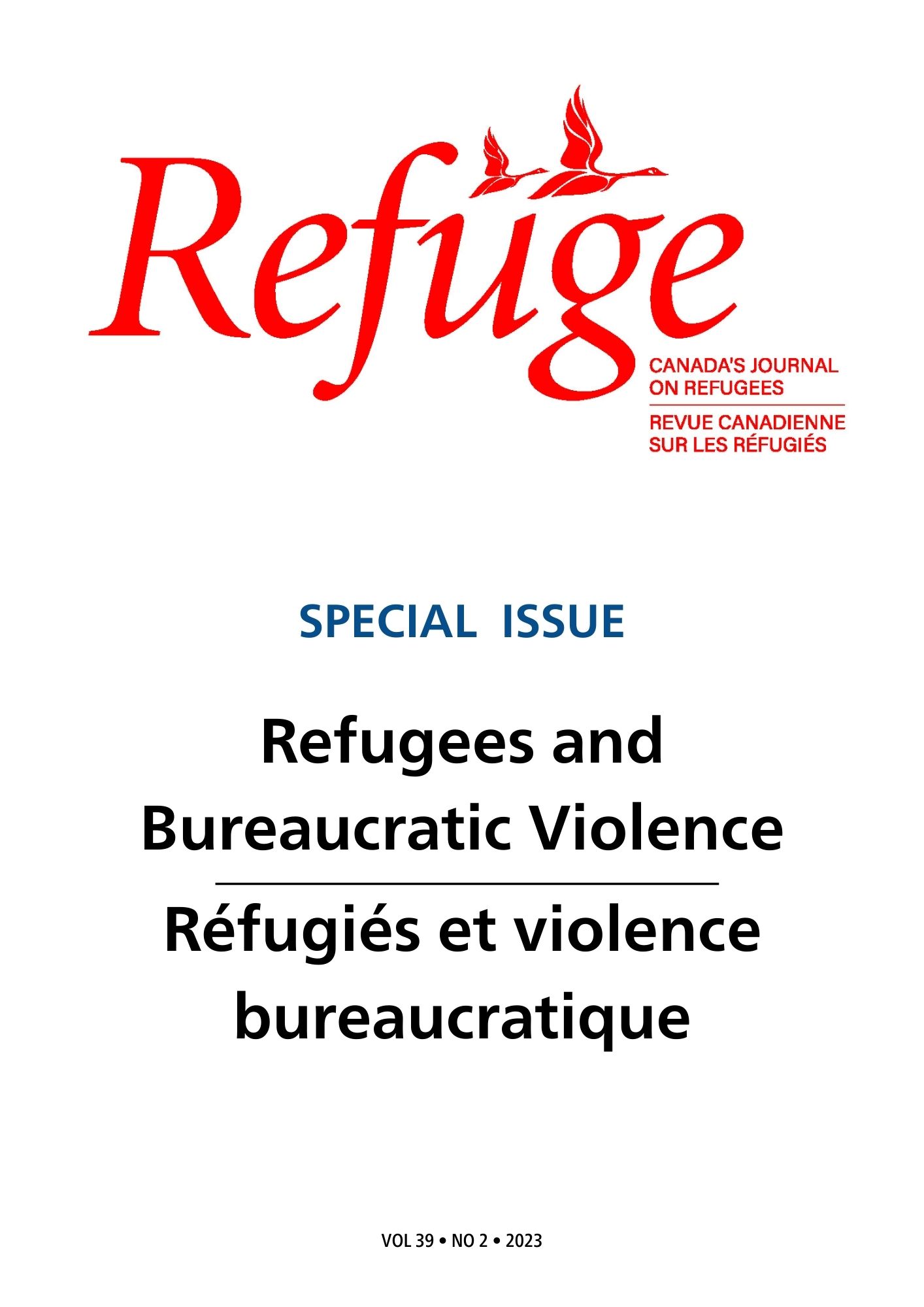What to Pack? The Semiotics of Be-Longing(s) of Syrian Displaced Women
DOI:
https://doi.org/10.25071/1920-7336.40959Keywords:
Refugees, Displaced Women, Syria, Jordan, Home, Semiotics, Lyrical SociologyAbstract
This qualitative study focuses on a group of 42 Syrian displaced women who live in Irbid, Jordan. The women went through the traumatic experience of forced eviction from their homes as a consequence of the civil war in Syria. The participants responded to a questionnaire about the most important things that they packed and whether the objects affected their coping with displacement. Our discussion of the socio-semiotic implications of the carried items validates our main thesis that the displaced women were empowered by the agency of commitment to the re-creation of home life away from home by solidly grounding it in the “dailiness” of domesticity. Through concept-driven coding, the study defines the pervasive patterns of the participants’ responses to the questions about their carried objects in relation to concepts of identity, home, and memory. The conclusion confirms that the women’s commitment to their roles as mothers and homemakers, along with their religious faith-based awareness of displacement, contributes to their sense of agency and resilience.
Metrics
References
Abbott, A. (2007). Against narrative: A preface to lyrical sociology. Sociological Theory, 25(1), 67–99. https://doi.org/10.1111/j.1467-9558.2007.00298.x DOI: https://doi.org/10.1111/j.1467-9558.2007.00298.x
Abinader, E. (2008). This house, my bones. In H. Charara (Ed.), Inclined to speak: An anthology of contemporary Arab American poetry (pp. 8–10). University of Arkansas Press. https://doi.org/10.2307/j.ctt1ffjj0g.6 DOI: https://doi.org/10.2307/j.ctt1ffjj0g.6
Alhayek, K. (2014a). Activism, communication technologies, and Syrian refugee women’s issues [Master’s thesis, Ohio University].
Alhayek, K. (2014b). Double marginalization: The invisibility of Syrian refugee women’s perspectives in mainstream online activism and global media. Feminist Media Studies, 14(4), 696–700. https://doi.org/10.1080/14680777.2014.935205 DOI: https://doi.org/10.1080/14680777.2014.935205
Appadurai, A. (1986). Introduction: Commodities and the politics of value. In A. Appadurai (Ed.), Social life of things: Commodities in cultural perspective (pp. 3–63). Cambridge University Press. https://doi.org/10.1017/CBO9780511819582.003 DOI: https://doi.org/10.1017/CBO9780511819582.003
Bandura, A. (2006). Toward a psychology of human agency. Perspectives on Psychological Science, 1(2), 164–180. https://doi.org/10.1111/j.1745-6916.2006.00011.x DOI: https://doi.org/10.1111/j.1745-6916.2006.00011.x
Beaujouan, J., & A. Rasheed. (2020). Syrian crisis, Syrian refugees. In J. Beaujouan & A. Rasheed (Eds.), Syrian crisis, Syrian refugees: Voices from Jordan and Lebanon (pp. 7–25). Palgrave Macmillan. https://doi.org/10.1007/978-3-030-35016-1 DOI: https://doi.org/10.1007/978-3-030-35016-1_2
Belk, R. W. (1988). Possessions and the extended self. Journal of Consumer Research, 15(2), 139–169. https://doi.org/10.1086/209154 DOI: https://doi.org/10.1086/209154
Brown, B. (2001). Thing theory. Critical Inquiry, 28(1), 1–22. http://www.jstor.org/stable/1344258 DOI: https://doi.org/10.1086/449030
Brun, C., & A. Fábos. (2015). Making home in limbo? A conceptual framework. Refuge: Canada’s Journal on Refugees, 31(1), 5–17. https://doi.org/10.25071/1920-7336.40138 DOI: https://doi.org/10.25071/1920-7336.40138
Culcasi, K. (2017). Displacing territory: Refugees in the Middle East. International Journal of Middle East Studies, 49(2), 323–326. https://doi.org/10.1017/s0020743817000095 DOI: https://doi.org/10.1017/S0020743817000095
Culcasi, K. (2019). “We are men and women now”: Intimate spaces and coping labour for Syrian women refugees in Jordan. Transactions of the Institute of British Geographers, 44(3), 463–478. https://doi.org/10.1111/tran.12292 DOI: https://doi.org/10.1111/tran.12292
Davis, F. (1979). Yearning for yesterday: A sociology of nostalgia. Free Press.
Dudley, S. (2010). Feeling at home: Producing and consuming things in Karenni refugee camps on the Thai–Burma border. Population, Space and Place, 17(2), 742–755. https://doi.org/10.1002/psp.639 DOI: https://doi.org/10.1002/psp.639
Felski, R. (2022). Sociological writing as resonant writing. The Sociological Review, 70(4), 656–665. https://doi.org/10.1177/00380261221106521 DOI: https://doi.org/10.1177/00380261221106521
Haddad, Z. (2014, September). How the crisis is altering women’s roles in Syria. Forced Migration Review,47, 46–47. https://www.fmreview.org/syria/haddad
Jano, D. (2013). Kosovar multi-layer identity: What is the same, the different and in common with Albanian identity. Journal of European and International Affairs, 1(1), 27–40. https://ssrn.com/abstract=2465463
Kabeer, N. (1999). Resources, agency, achievements: Reflections on the measurement of women’s empowerment. Development and Change, 30(3), 435–464. https://doi.org/10.1111/1467-7660.00125 DOI: https://doi.org/10.1111/1467-7660.00125
Kanal, M., & Rottmann, S. B. (2021). Everyday agency: Rethinking refugee women’s agency in specific cultural contexts. Frontiers in Psychology, 12, Article 726729. https://doi.org/10.3389/fpsyg.2021.726729 DOI: https://doi.org/10.3389/fpsyg.2021.726729
Keane, W. (2003). Semiotics and the social analysis of material things. Language & Communication, 23(3–4), 409–425. https://doi.org/10.1016/s0271-5309(03)00010-7 DOI: https://doi.org/10.1016/S0271-5309(03)00010-7
Lim, I.-T. (2019). The imaginary as a method: “Lyrical sociology” as a heuristic of sociological description. Österreichische Zeitschrift für Soziologie, 44, 139–155. https://doi.org/10.1007/s11614-019-00377-w DOI: https://doi.org/10.1007/s11614-019-00377-w
Lokot, M. (2019). The space between us: Feminist values and humanitarian power in research with refugees. Gender & Development, 27(3), 467–484. https://doi.org/10.1080/13552074.2019.1664046 DOI: https://doi.org/10.1080/13552074.2019.1664046
Mahmood, S. (2001). Feminist theory, embodiment, and the docile agent: Some reflections on the Egyptian Islamic revival. Cultural Anthropology, 16, 202–236. http://doi.org/10.1525/can.2001.16.2.202 DOI: https://doi.org/10.1525/can.2001.16.2.202
Mercer, K. (1990). Welcome to the jungle: Identity and diversity in postmodern politics. In J. Rutherford (Ed.), Identity: Community, culture, difference (pp. 43–70). Lawrence & Wishart. https://muse.jhu.edu/book/34784
Naguib, N. (2017). Middle East encounters 69 degrees north latitude: Syrian refugees and everyday humanitarianism in the Arctic. International Journal of Middle East Studies, 49(4), 645–660. https://doi.org/10.1017/s0020743817000630 DOI: https://doi.org/10.1017/S0020743817000630
Pandir, M. (2020). Media portrayals of refugees and their effects on social conflict and social cohesion. Perceptions, 25(1), 99–120. https://dergipark.org.tr/en/pub/perception/issue/56044/769639
Sarup, M. (1996). Identity, culture and the postmodern world. Edinburgh University Press. https://doi.org/10.1515/9781474472272 DOI: https://doi.org/10.1515/9781474472272
Sayre, S. (1994). Possessions and identity in crisis: Meaning and change for victims of the Oakland firestorm. Advances in Consumer Research, 21, 109–114. https://www.acrwebsite.org/volumes/9867/volumes/v21/NA-21
Specia, M. (2018, April 13). How’s Syria’s death toll is lost in the fog of war. The New York Times. https://www.nytimes.com/2018/04/13/world/middleeast/syria-death-toll.html
Stewart, S. (1993). On longing: Narratives of the miniature, the gigantic, the souvenir, the collection. Duke University Press. https://doi.org/10.2307/j.ctv1220n8g DOI: https://doi.org/10.1515/9780822378563
Tolia-Kelly, D. (2004). Locating processes of identification: Studying the precipitates of re-memory through artefacts in the British Asian home. Transactions of the Institute of British Geographers, 29(3), 314–329. http://www.jstor.org/stable/3804494 DOI: https://doi.org/10.1111/j.0020-2754.2004.00303.x
Trentmann, F. (2009). Materiality in the future of history: Things, practices, and politics. Journal of British Studies, 48(2), 283–307. https://doi.org/10.1086/596123 DOI: https://doi.org/10.1086/596123
UNHCR. (2012). UNHCR global report 2012—Jordan. https://www.unhcr.org/51b1d63bd.pdf
UNHCR. (2021, August 3). UNHCR Jordan: Zaatari refugee camp—Factsheet, June 2021 [Press release]. https://reliefweb.int/report/jordan/unhcr-jordan-zaatari-refugee-camp-factsheet-june-2021
UNHCR. (2022). Operational data portal: Refugee situations. Retrieved August 23, 2022, from https://data2.unhcr.org/en/situations/syria/location/36
United Nations Office for the Coordination of Humanitarian Affairs (OCHA). (2018). The Syria crisis in numbers. https://unocha.exposure.co/the-syria-crisis-in-numbers
Winton, A. G. (2013). Inhabited space: Critical theories and the domestic interiors. In L. Weinthal & G. Brooker (Eds.), The handbook of interior architecture and design (pp. 40–49). Bloomsbury Academic. DOI: https://doi.org/10.5040/9781474294096.ch-003
Downloads
Published
How to Cite
Issue
Section
License
Copyright (c) 2024 Fadia F. Suyoufie, Abdullah M. Dagamseh

This work is licensed under a Creative Commons Attribution-NonCommercial 4.0 International License.
Refuge authors retain the copyright over their work, and license it to the general public under the Creative Commons Attribution-Non Commercial License International (CC BY-NC 4.0). This license allows for non-commercial use, reproduction and adaption of the material in any medium or format, with proper attribution. For general information on Creative Commons licences, visit the Creative Commons site. For the CC BY-NC 4.0 license, review the human readable summary.







